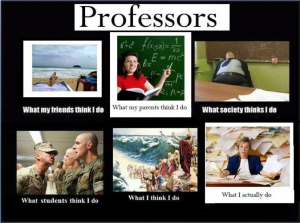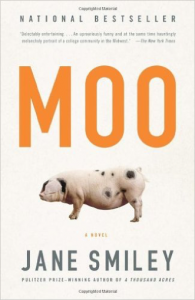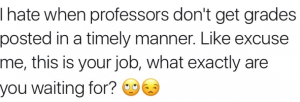
By Jennifer Forsthoefel
Here is an example of a popular meme depicting how different groups might understand the role of the professor. Friends may believe professors have summers off; parents may liken them to a school teacher; society may assume they show students movies to pass the time. Although I wouldn’t liken what I do to a divine parting of the seas, I believe my work impacts my students, colleagues, and the discipline in valuable ways. I have never heard my students characterize me as a drill sergeant (to my face) and while I do spend a lot of time grading, it isn’t all I “actually do.” Which brings me to what I find most interesting about this meme: what do people think professors do? What do our students believe about our job, and how do their assumptions square with reality?
In Spring 2016, I taught an English 1102 course entitled “Inventing the University: Popular Depictions of Higher Education.” My initial interest in teaching this course stemmed from my research on patterns of administrative and departmental structures in higher education. I am consistently intrigued by how professional identities that are articulated within the academy translate to those outside of it. For me, assessing representations of higher education in popular culture allows for insight to into these translations.
I was also inspired by materials from Rebecca Weaver’s course “The Fictional Life of College” which she graciously shared with me. Throughout the semester, my students in “Inventing the University” examined books by J. Courtney Sullivan, Jane Smiley, and Julie Schumacher and television shows and movies such as A Different World, Community, Animal House, and Mona Lisa Smile to find patterns in their depictions of college life. We also read journalistic accounts of the lives of students, administrators, and faculty at community colleges, women’s colleges, HBCUs, and research universities, comparing those perspectives to fictional representations and to students’ personal experiences. We discussed the ways in which liberal and instrumentalist views of education were fostered in fictional representations and debated about the value of current trends in educational philosophy with passionate viewpoints coming from all sides of the issue. However, a surprising addition to these discussions was a peek into students’ expectations of their professors and their assumptions about what a professor’s job entails. It was then that I realized how misinformed many students were about the job of an academic. Generally speaking, the research and service components remained utterly invisible to most of my undergraduate students. To these students, teaching and tending to the academic well-being of students were the primary responsibility of university professors.

Academic Novels
Throughout the course, I assigned several academic novels, including Jane Smiley’s Moo, which is set in a Midwestern agricultural university and depicts the personal and professional lives of its faculty and students. This novel has over twenty-five prominent characters, including Mary Jackson, an African-American student navigating her personal and academic goals at a predominantly white institution; Dr. Ivar Harstad, a provost who is frantically negotiating to alleviate university budget constraints; Dr. Timothy Monohan, a novelist up for tenure in the English department; Joy Pfisterer, an instructor in the Animal Science department struggling to gain the approval of her peers; and Dr. Lionel Gift, a prominent Economics professor exploiting his charity connections for financial gain. I asked my students to analyze the novel’s representations of the different constituents in the fictionalized university—including students, tenured and untenured faculty, deans, provosts, corporate investors, and various administrative staff—and compare these portrayals to broader journalistic and scholarly accounts of those figures. While several students scrutinized student and administrative characters in the novel, many focused on the faculty, specifically the ways in which the faculty were not sufficiently attending to their responsibilities in the classroom. Instead of seeing his motivation to collaborate with and be inspired by his students, they saw Dr. Timothy Monohan as selfish and irresponsible for having his class study material pertinent to his next novel. Rather than sympathizing with Joy Pfisterer for being silenced by a tenure-track faculty member in her department (who also happens to be her romantic partner), they criticized her for not investing more time into her students’ assessment of her performance. Instead of recognizing Dr. Lionel Gift as using a system that exploits him to his own advantage, they concluded that he only cares about money and not the students at his university. Consistently, my students claimed that these characters were not good teachers, did not care about their students, and were not doing their jobs as professors by focusing on research. The novel depicts a university in crisis, but rather than attributing this to bureaucratic and structural inequities, as I had, my students placed the blame on the faculty. They concluded that the book depicted a university that was not accomplishing its intended purpose: to educate students.
It surprised me how different my students’ responses to the faculty portrayed in the novel were from my own. Yes, the teachers are depicted as having complicated personal lives and frequent concerns about their research being funded or accepted into the scholarly community. But it did not seem to me that these concerns outweighed their teaching obligations. Yet this was a drastically different impression from that of my students. Why might these differences in perception exist?

As we know, most faculty members, particularly those on the tenure-track who work in a Research-1 institution like Georgia Tech, have three categories of job responsibility: teaching, service, and research. These categories include teaching and advising undergraduate and graduate students, serving on departmental committees and larger editorial boards, fulfilling obligations to administrative roles, contributing to local community initiatives, researching, writing, revising, and publishing scholarly manuscripts, and much more. The demands of a professor go beyond teaching students for an hour a few times a week. Faculty members attend meetings, coordinate collaborations, prepare lectures, plan conferences, organize funding opportunities, and facilitate partnerships in addition to their teaching responsibilities, stretching well beyond the forty-hour work week. Professors are not only teachers—they are researchers, scholars, editors, mentors, administrators, advisors, consultants, collaborators, as well as partners, parents, activists, and the like.
Contingent Faculty
It is important to note that, while the majority of professors depicted in popular culture are tenure-track faculty members, I am not. I am not a professor; I am contingent faculty, a Brittain Postdoctoral Fellow. My job responsibilities include teaching courses, advising students, serving on program committees, and publishing research in spaces that range from nationally recognized disciplinary spheres to locally housed teaching and learning venues. You could make the argument that an adjunct, Visiting Assistant Professor, or Postdoc is a faculty member whose primary responsibility is teaching, but as we all know too well, contingent faculty have their own kind of obligation to research. Scholarly publication is the currency of the academic job market, and if contingent faculty hope to gain job security, they too must conduct research, attend conferences, and publish their findings. Thus, ensuring that our students are informed about the job requirements and obligations of a professional academic is important and relevant, even to contingent faculty.
It is hard to know why students might misinterpret the job of the professor, but popular culture surely plays a role. In a study published in 2011, sociologists Mari Dagaz and Brent Harger examined depictions of college professors in popular films from 1985-2005 and found that these stories tended to villainize professors, particularly female professors, who focused on research rather than nurturing their students. In her 2014 monograph Representing “U”: Popular Culture, Media, and Higher Education, Pauline Reynolds explains that in fictional representations of higher education, “teaching and research are often portrayed in ways that normatively represent research and scholarly pursuits as bad in comparison with teaching as good. Alternatively, scholarship is ignored and teaching retains the distinction of being the professional act of professors” (63). In other words, popular culture teaches students that professors’ research—when it is acknowledged at all—is a distraction from their main job, which takes place in the classroom. Thus, students may arrive at the university with many of the misconceptions in place and be disappointed to discover that their professors have additional responsibilities beyond the undergraduate classroom.

In addition, students may conflate the roles of teacher and professor and therefore apply their experiences from high school to their professors at a university. While high school teachers have a vast array of job responsibilities, the majority of high school teachers do not have research expectations. Without informing students about these differences, they cannot be aware of the impact these expectations may have on fulfilling all of the job responsibilities of professors. The consequences of this misunderstanding may impact student evaluations, an already increasingly unreliable measurement of teacher effectiveness. If students are not aware of what the job responsibilities are for those who are teaching their courses, how can they be expected to evaluate whether we have met those responsibilities?
Conclusion
Students might not know what their professors do because no one may have told them. After taking the time to articulate to my students the many demands that a professor’s job entails, they were able to recognize the benefit of that work in terms of the quality of their education: the research professors do advances their fields of study, and their service makes connections for that research to make an impact beyond the academy. These are outcomes that my students could understand and invest in. In addition, the topic of my course allows me to talk about my position in the university as a Postdoc, particularly the economic and temporal difficulties I face as a result of being contingent faculty—even how my employment expectations and compensation are better than the adjuncts and lecturers at other universities. However, professors and contingent faculty may broach this topic of conversation with their students regardless of the material being studied. We can give students the opportunity to understand how a university functions—in the ways that are valuable and in ways that are objectionable—by having a frank and open discussion with students about what our position entails, be it as a professor or a postdoctoral fellow. We can articulate to our students what our relationship is to them and their education. We can talk to our students about the labor market in the academy. Some contingent faculty even tell their students not to call them “professor” in order to highlight the differences in working conditions at varying levels of employment. Even a short conversation about the full range of faculty responsibilities might prevent disappointment and frustration from our students in our performance and in that of their future professors. Armed with a better understanding of the many facets of their professors’ job in the academy, students can be better equipped to form important educational partnerships with those who teach their courses.
If you would like to read more on how Brittains adapt their pedagogy to modern concerns, consider Jeff Howard’s on Tech’s Common First Week video or Jeffrey Fallis’ article on how poetry saved his pedagogy.
Works Cited
Dagaz, Mari and Brent Harger. “Race, Gender, and Research: Implications for Teaching from Depictions of Professors in Popular Film, 1985-2005.” Teaching Sociology. 39.3 (2011): 274-289. Print.
Reynolds, Pauline J. Representing “U”: Popular Culture, Media, and Higher Education. Hoboken, NJ: Jossey-Bass, 2014. Print
Smiley, Jane. Moo: A Novel. New York, NY: Anchor, 2011. Print.
